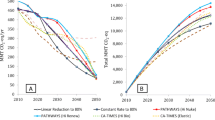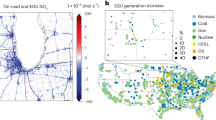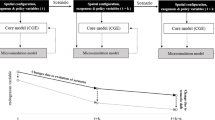Abstract
California Governor’s Executive Order (CGEO) S-3-05 requires that California greenhouse gas (GHG) emissions be reduced to 80 % below 1990 levels by the year 2050. Meeting this target will require drastic changes in transportation technology, fuel, and behavior which will reduce criteria pollutant emissions as well as GHG emissions. The improvement to local air quality caused by the reduced criteria pollutant emissions must be calculated to fully evaluate the overall benefits and costs of CGEO S-3-05. In the present study, seven different transportation scenarios that move towards the goals of CGEO S-3-05 in the transportation sector were examined to determine how they would affect future airborne particulate matter (PM2.5) concentrations in California: (1) hydrogen fuel cells, (2) electric vehicles, (3) high efficiency vehicles, (4) public mass transit, (5) biofuels, (6) biofuels + hybrid electric vehicles, and (7) hydrogen fuel cells + electric vehicles. The air quality implications of each scenario were evaluated using a chemical transport model applied during a wintertime stagnation episode representing future climate in California. Scenarios (6) and (7) reduced population-weighted PM2.5 mass concentrations by ~9 % and PM2.5 elemental carbon (EC) concentrations by ~30 % relative to base-case predictions.



Similar content being viewed by others
References
A Comprehensive Analysis of Biodiesel Impacts on Exhaust Emissions (2002). United States Environmental Protection Agency, EPA420-P-02-001
California Council on Science and Technology (May 2011) California’s energy future - the view to 2050
California Department of Finance (May 2012) Interim Population Projections for California and Its Counties 2010–2050. www.dof.ca.gov/research/demographic/reports/projections/interim/view.php
California Department of Resources Recycling and Recovery (2011) Solid waste information system (SWIS). CalRecycle.ca.gov/SWFacilities/Directory/
California Energy Commission (2012) Database of California power plants. http://energyalmanac.ca.gov/powerplants/index
California Greenhouse Gases, Regulated Emissions, and Energy Use in Transportation (GREET) Model (2007) California Air Resources Board, Sacremento CA
CARB (2010a) Greenhouse Gas Inventory Data - 2000 to 2008. 2000–2008 Emissions trends. California Air Resources Board. arb.ca.gov/cc/inventory/data/data.htm Accessed May 31 2011
CARB (2010b) Greenhouse Gas Inventory Data - 2000 to 2008. 2000–2008 Inventory by Scoping Plan Category - Summary. California Air Resources Board. arb.ca.gov/cc/inventory/data/data.htm Accessed May 31 2011
Delucchi MA (2006) Lifecycle analyses of biofuels: draft report
Flannigan MD, Vanwagner CE (1991) Climate change and wildfire in canada. Can J For Res-Revue Canadienne De Recherche Forestiere 21(1):66–72
Fried JS, Torn MS, Mills E (2004) The impact of climate change on wildfire severity: a regional forecast for northern California. Clim Chang 64(1–2):169–191
Friel S, Dangour AD, Garnett T, Lock K, Chalabi Z, Roberts I, Butler A, Butler CD, Waage J, McMichael AJ, Haines A (2009) Public health benefits of strategies to reduce greenhouse-gas emissions: food and agriculture. Lancet 374(9706):2016–2025. doi:10.1016/s0140-6736(09)61753-0
Haines A, McMichael AJ, Smith KR, Roberts I, Woodcock J, Markandya A, Armstrong BG, Campbell-Lendrum D, Dangour AD, Davies M, Bruce N, Tonne C, Barrett M, Wilkinson P (2009) Public health benefits of strategies to reduce greenhouse-gas emissions: overview and implications for policy makers. Lancet 374(9707):2104–2114. doi:10.1016/s0140-6736(09)61759-1
Hixson M, Mahmud A, Hu JL, Bai S, Niemeier DA, Handy SL, Gao SY, Lund JR, Sullivan DC, Kleeman MJ (2010) Influence of regional development policies and clean technology adoption on future air pollution exposure. Atmos Environ 44(4):552–562. doi:10.1016/j.atmosenv.2009.10.041
Mahmud A, Hixson M, Hu J, Zhao Z, Chen SH, Kleeman MJ (2010) Climate impact on airborne particulate matter concentrations in California using seven year analysis periods. Atmos Chem Phys 10(22):11097–11114. doi:10.5194/acp-10-11097-2010
Markandya A, Armstrong BG, Hales S, Chiabai A, Criqui P, Mima S, Tonne C, Wilkinson P (2009) Public health benefits of strategies to reduce greenhouse-gas emissions: low-carbon electricity generation. Lancet 374(9706):2006–2015. doi:10.1016/s0140-6736(09)61715-3
McCollum D, Yang C, Yeh S, Ogden J (2012) Deep greenhouse gas reduction scenarios for California-Strategic implications from the CA-TIMES energy-economic systems model. energy strategy reviews
Millstein DE, Harley RA (2010) Effects of retrofitting emission control systems on in-use heavy diesel vehicles. Environ Sci Technol 44(13):5042–5048. doi:10.1021/es1006669
Nemet GF, Holloway T, Meier P (2010) Implications of incorporating air-quality co-benefits into climate change policymaking. Environ Res Lett 5(1):014007. doi:10.1088/1748-9326/5/1/014007
Netherlands Environmental Assessment Agency (2009) Co-benefits of climate policy. Netherlands Environmental Assessment Agency, Bilthoven
Organisation for Economic Co-operation and Development (2009) Co-benefits of climate change mitigation policies: literature review and new results
Population Projections by Race/Ethnicity for California and Its Counties, 2000–2050 (2004) California Department of Finance, Sacramento, California
Proposed regulation to implement the low carbon fuel standard. Volume I. Staff Report: initial statement of reasons (2009). California Air Resources Board, Sacramento CA
Smith KR, Jerrett M, Anderson HR, Burnett RT, Stone V, Derwent R, Atkinson RW, Cohen A, Shonkoff SB, Krewski D, Pope CA, Thun MJ, Thurston G (2009) Public health benefits of strategies to reduce greenhouse-gas emissions: health implications of short-lived greenhouse pollutants. Lancet 374(9707):2091–2103. doi:10.1016/s0140-6736(09)61716-5
Stocks BJ, Fosberg MA, Lynham TJ, Mearns L, Wotton BM, Yang Q, Jin JZ, Lawrence K, Hartley GR, Mason JA, McKenney DW (1998) Climate change and forest fire potential in Russian and Canadian boreal forests. Clim Chang 38(1):1–13
U.S. Department of Energy (2011) Refinery hydrogen production capacity by state. hydrogen.pnl.gov/cocoon/morf/hydrogen/article/706
Westerling AL, Hidalgo HG, Cayan DR, Swetnam TW (2006) Warming and earlier spring increase western US forest wildfire activity. Science 313(5789):940–943
Wilkinson P, Smith KR, Davies M, Adair H, Armstrong BG, Barrett M, Bruce N, Haines A, Hamilton I, Oreszczyn T, Ridley I, Tonne C, Chalabi Z (2009) Public health benefits of strategies to reduce greenhouse-gas emissions: household energy. Lancet 374(9705):1917–1929. doi:10.1016/s0140-6736(09)61713-x
Woodcock J, Edwards P, Tonne C, Armstrong BG, Ashiru O, Banister D, Beevers S, Chalabi Z, Chowdhury Z, Cohen A, Franco OH, Haines A, Hickman R, Lindsay G, Mittal I, Mohan D, Tiwari G, Woodward A, Roberts I. (2009) Public health benefits of strategies to reduce greenhouse-gas emissions: urban land transport. Lancet 374(9705):1917–1929. doi:10.1016/s0140-6736(09)61714-1
Yang C, McCarthy RW, Lamont AD, Ogden JM, White RG, Stewart JS (2008) Evaluating the effects of advanced energy system pathays on energy flows and emissions in California
Yang C, McCollum D, McCarthy R, Leighty W (2009) Meeting an 80 % reduction in greenhouse gas emissions from transportation by 2050: a case study in California. Transp Res Part D: Transp Environ 14(3):147–156. doi:10.1016/j.trd.2008.11.010
Zapata C, Muller N, Kleeman MJ (2012) PM2.5 Co-benefits of climate change legislation part 1: California’s AB 32. Climatic change (in press)
Acknowledgments
This study was funded by the United States Environmental Agency under Grant No. RD-83184201. Although the research described in the article has been funded by the United States Environmental Protection Agency it has not been subject to the Agency’s required peer and policy review and therefore does not necessarily reflect the reviews of the Agency and no official endorsement should be inferred.
Author information
Authors and Affiliations
Corresponding author
Electronic supplementary material
Below is the link to the electronic supplementary material.
ESM 1
(DOCX 13144 kb)
Rights and permissions
About this article
Cite this article
Kleeman, M.J., Zapata, C., Stilley, J. et al. PM2.5 co-benefits of climate change legislation part 2: California governor’s executive order S-3-05 applied to the transportation sector. Climatic Change 117, 399–414 (2013). https://doi.org/10.1007/s10584-012-0546-x
Received:
Accepted:
Published:
Issue Date:
DOI: https://doi.org/10.1007/s10584-012-0546-x




